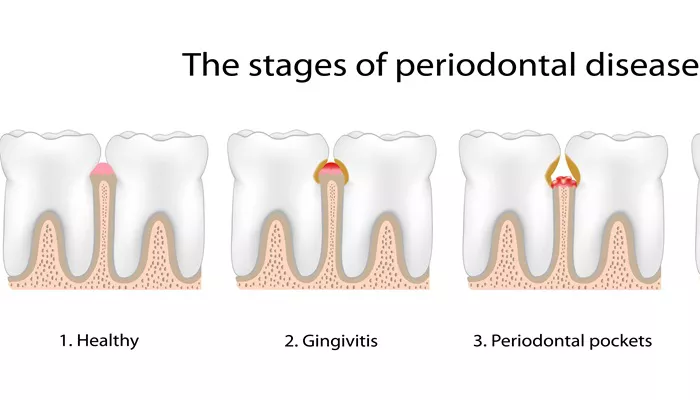Periodontal disease, commonly known as gum disease, is a serious condition that affects the tissues surrounding the teeth.
It is a progressive disease that can lead to tooth loss and has been linked to various systemic health issues. Among the stages of periodontal disease, Stage 3, or advanced periodontitis, represents a critical point in the disease’s progression.
This article aims to provide a comprehensive overview of Stage 3 periodontal disease, including its causes, symptoms, diagnosis, treatment options, and the importance of prevention.
Introduction to Periodontal Disease
Periodontal disease begins with gingivitis, the mildest form of gum disease characterized by inflammation of the gums. If left untreated, gingivitis can progress to periodontitis, where the inflammation extends deeper into the supporting structures of the teeth.
Periodontitis is classified into different stages based on the severity of the disease, with Stage 3 being one of the most severe forms.
Stage 3 periodontal disease is marked by significant damage to the supporting bone structures and deeper periodontal pockets. This stage requires immediate and comprehensive treatment to manage the disease and prevent further complications. Understanding the characteristics and implications of Stage 3 periodontal disease is essential for both patients and dental professionals.
SEE ALSO: How Long Does It Take to Reverse Periodontal Disease
Causes of Stage 3 Periodontal Disease
The progression to Stage 3 periodontal disease is influenced by several factors, including:
Poor Oral Hygiene: Inadequate brushing and flossing allow plaque to accumulate on the teeth and gums, leading to inflammation and infection.
Tobacco Use: Smoking and other forms of tobacco use can impair blood flow to the gums, hinder healing, and increase the risk of periodontal disease.
Genetic Predisposition: Some individuals may be genetically predisposed to periodontal disease, making them more susceptible to its progression.
Systemic Conditions: Diseases such as diabetes, cardiovascular disease, and autoimmune disorders can exacerbate periodontal disease and complicate its management.
Hormonal Changes: Fluctuations in hormones, such as those experienced during pregnancy or menopause, can affect gum health and increase the risk of periodontal disease.
Nutritional Deficiencies: A diet lacking in essential nutrients, particularly vitamin C, can weaken the immune system and reduce the body’s ability to fight infections.
Symptoms of Stage 3 Periodontal Disease
Recognizing the symptoms of Stage 3 periodontal disease is crucial for timely intervention. Common signs and symptoms include:
Deepening Periodontal Pockets: The spaces between the teeth and gums become deeper, often exceeding 6 millimeters.
These pockets can trap bacteria and debris, leading to further infection.
Gum Recession: The gums may recede significantly, exposing the roots of the teeth and increasing sensitivity.
Tooth Mobility: As the supporting bone deteriorates, teeth may become loose or shift position, leading to bite problems.
Pus Formation: Infected pockets may produce pus, which can be a sign of severe infection.
Persistent Bad Breath: Halitosis, or bad breath, is often a result of the bacterial infection present in the gums.
Pain and Discomfort: Patients may experience pain, tenderness, or discomfort in the gums, especially when chewing or brushing.
Diagnosis of Stage 3 Periodontal Disease
Diagnosing Stage 3 periodontal disease typically involves a comprehensive dental examination, including:
Clinical Examination: A dentist or periodontist will assess the health of the gums, measure probing depths, and check for signs of inflammation or infection.
Radiographic Evaluation: X-rays are used to evaluate the extent of bone loss around the teeth and to identify any other underlying issues.
Periodontal Charting: This involves recording the depth of periodontal pockets, the presence of bleeding, and the level of tooth mobility.
The combination of clinical findings and radiographic evidence helps dental professionals determine the severity of the periodontal disease and develop an appropriate treatment plan.
Treatment Options for Stage 3 Periodontal Disease
Stage 3 periodontal disease requires a multifaceted approach to treatment. The primary goals are to control the infection, reduce inflammation, and restore the health of the supporting structures.
Treatment options may include:
Scaling and Root Planing (SRP): This deep cleaning procedure removes plaque and tartar from above and below the gum line. It smooths the root surfaces to promote healing and reattachment of the gums.
Antibiotic Therapy: In some cases, systemic or localized antibiotics may be prescribed to help control bacterial infection and inflammation.
Surgical Interventions: If non-surgical treatments are insufficient, surgical options may be necessary. These can include:
Flap Surgery: The gums are lifted back to allow for thorough cleaning of the roots and bone. The gum tissue is then repositioned to reduce pocket depth.
Bone Grafting: This procedure involves adding bone or bone-like material to areas where bone has been lost, promoting regeneration and stabilization of the teeth.
Guided Tissue Regeneration: A barrier is placed between the gum tissue and the bone to encourage the growth of new bone and tissue.
Maintenance Therapy: After initial treatment, regular periodontal maintenance visits are essential. These visits involve professional cleanings and monitoring to prevent recurrence of the disease.
Importance of Prevention And Regular Dental Visits
Preventing the progression of periodontal disease is crucial. Patients should adopt good oral hygiene practices, including:
Daily Brushing and Flossing: Brushing at least twice a day and flossing daily helps remove plaque and prevent its buildup.
Regular Dental Check-ups: Routine visits to the dentist for cleanings and examinations can help identify early signs of periodontal disease and allow for timely intervention.
Healthy Lifestyle Choices: Avoiding tobacco, maintaining a balanced diet, and managing systemic health conditions can significantly reduce the risk of developing periodontal disease.
Conclusion
Stage 3 periodontal disease, or advanced periodontitis, is a serious condition that can lead to significant oral health complications if left untreated. Understanding its causes, symptoms, and treatment options is essential for effective management. With proper care and regular dental visits, patients can control the disease and maintain their oral health.
Early detection and intervention are key to preventing the progression of periodontal disease. By recognizing the signs and symptoms and seeking timely dental care, individuals can protect their teeth and gums from the devastating effects of advanced periodontitis.

